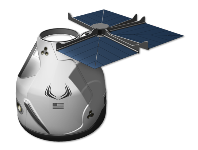Reentry capsule to bring cargo from space back to Earth. Global Delivery of Supplies. Space Station Resupply and Return. Resource Return.
Created: 2021-12-24
Updated: 2025-09-06
Company - Inversion Space
Product/Service - Ray, Arc
- Classification
- Cargo Transportation & Landers
- Category
- Transport Service (Re-Entry)
In-Space Manufacturing
Microgravity Flight Service (LEO)
Microgravity Flight Service (Reusable Satellite)
- Fields
- Space Capsule
- Status
- Development, Launched
- First launch
- 2025
Inversion Space targets military market with ‘warehouses in space’, 2024-05-16.
- Setting its sights on revolutionizing military logistics with its concept of “warehouses in space.”
- The company envisions deploying reusable reentry capsules to store cargo in orbit, and delivering it to any point on Earth within an hour.
- A pathfinder mission dubbed “Ray” is scheduled for launch as early as October on the SpaceX Transporter-12 rideshare mission.
- Inversion envisions itself as a “warehousing and transportation company,” Fiaschetti told SpaceNews. “We would store cargo in space, and when it’s needed, deliver it in under an hour,” he said. The capsules could transport anything from medical supplies and battlefield gear to small surveillance drones.
Inversion Space accelerates orbital reentry vehicle tech with $71M Space Force contract, 2024-09-10.
- Inversion will be launching a subscale pathfinder capsule called Ray on the SpaceX Transporter-12 rideshare mission.
- Equipped with a new $71 million contract from SpaceWERX, the technology development arm of the U.S. Space Force, Inversion is now racing toward a demonstration mission of its full-scale reentry vehicle as soon as 2026.
Technical Deep-Dive: Inversion’s First Mission on Orbit, 2025-06-11.
- Four minutes and 21 seconds after deployment the mission control dashboard lit up with state-of-health telemetry on Ray.
- An over-current event on a Bipolar Junction Transistor used to trigger the spark plug used for igniting our engine’s ignition chamber had shorted.
- Conducted two cold-flow delta-V maneuvers to demonstrate Ray’s orbital maneuverability.
- Nearly every system on board was developed in-house by a team of just 25 people.
- Ray’s bill of materials came in well under $1 million.
Status Comment
First mission launched on 2025-01-14, but unable to return to Earth due to propulsion issues.
Notes
Sources
Most sources should be linked in the texts and headings as revealed by mouse-over, but here are they listed for visibility.










































































































































































































.png)






















.jpg)




































































